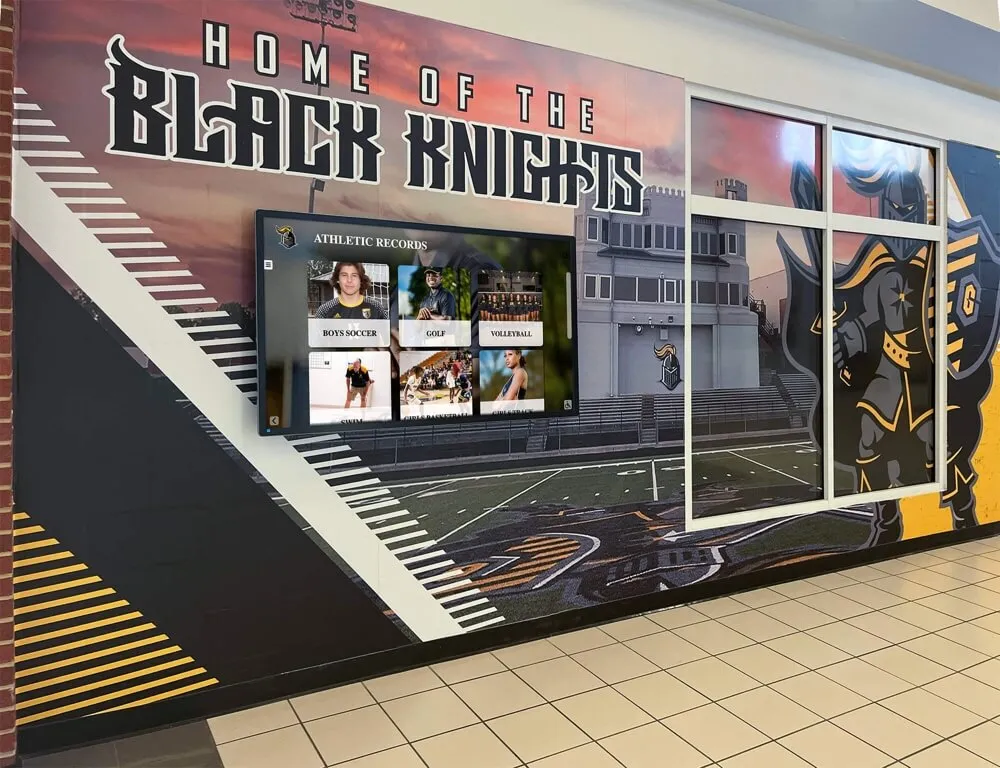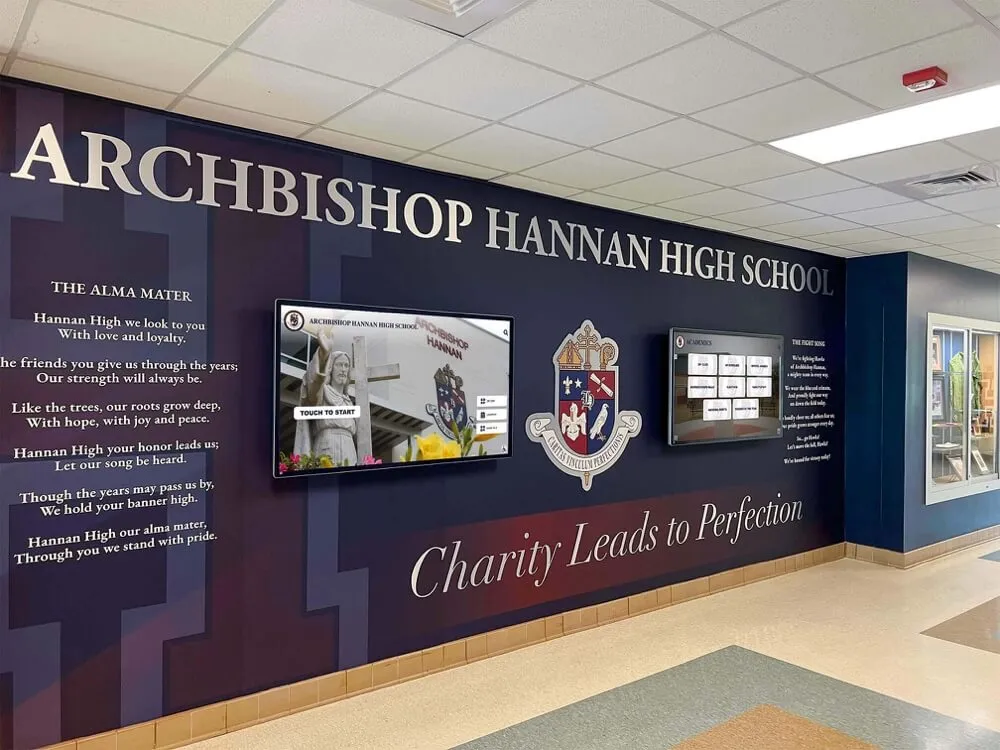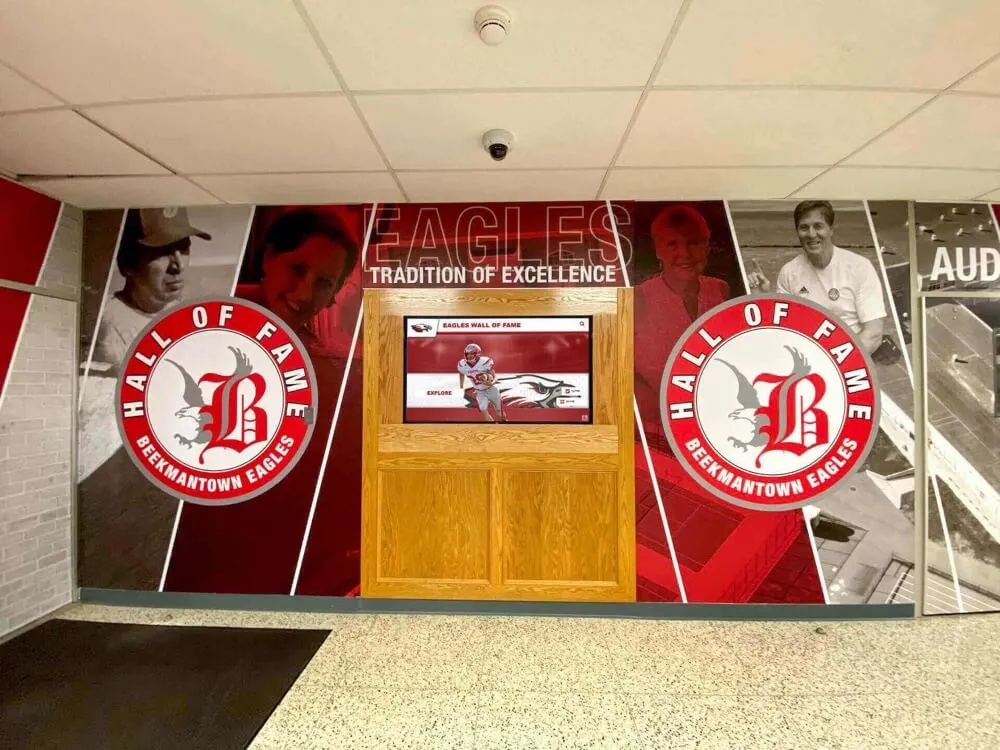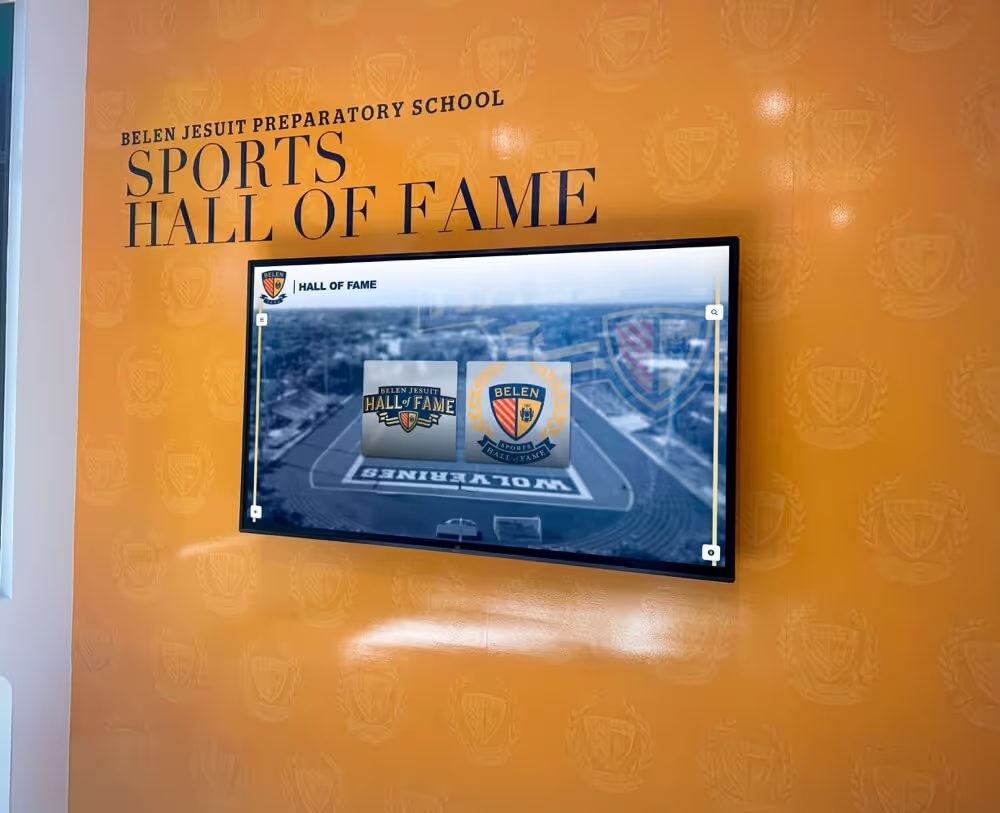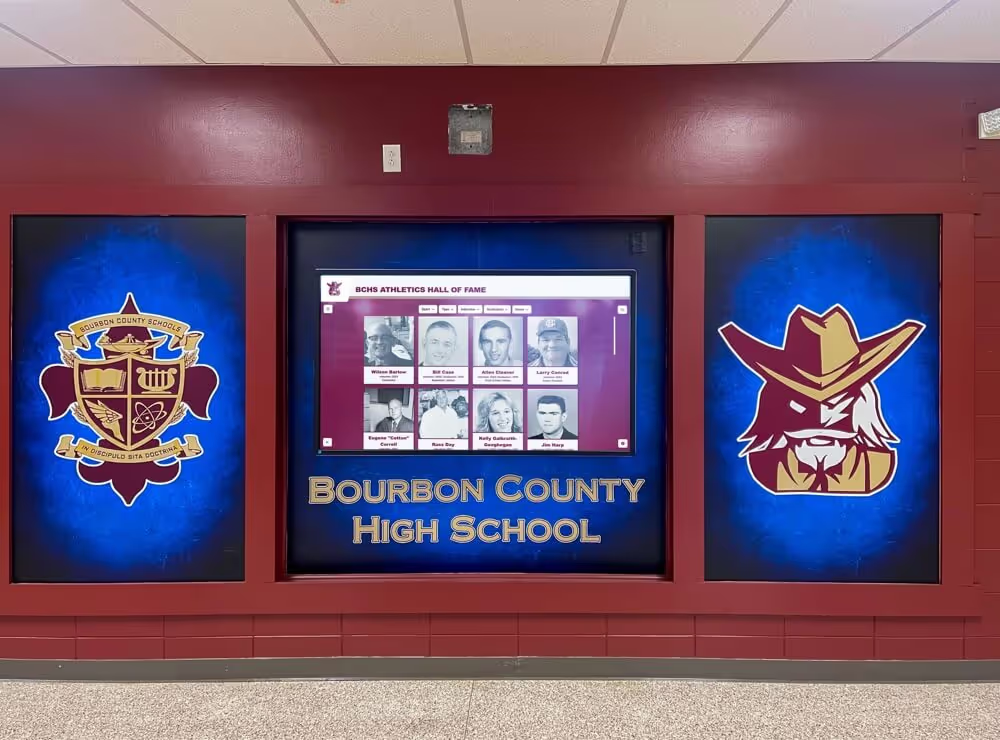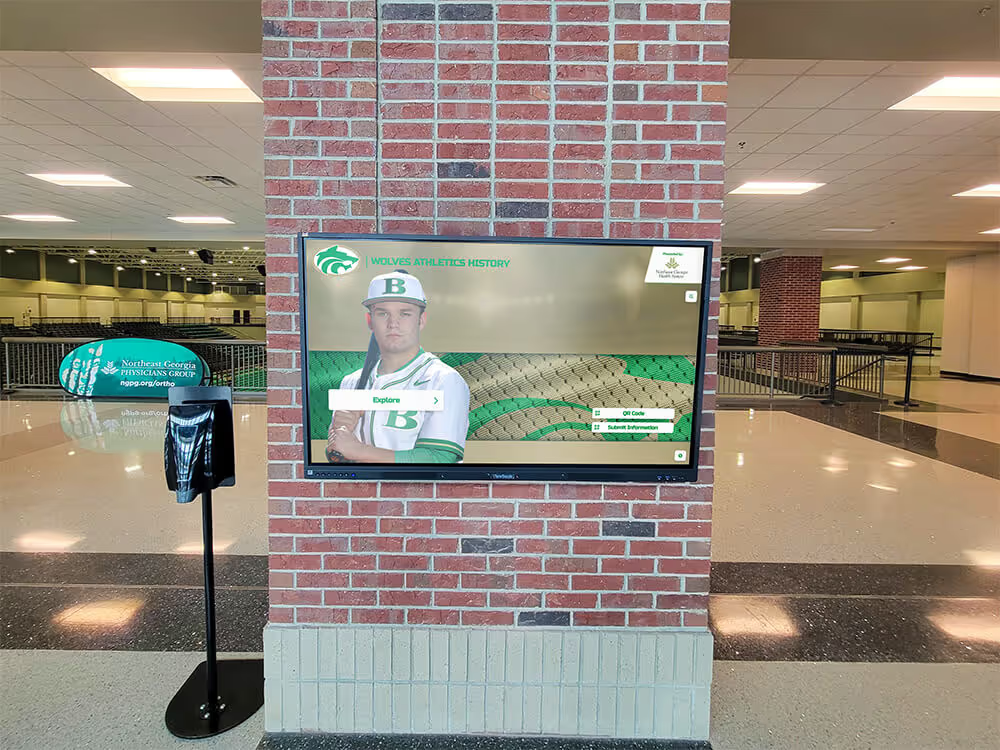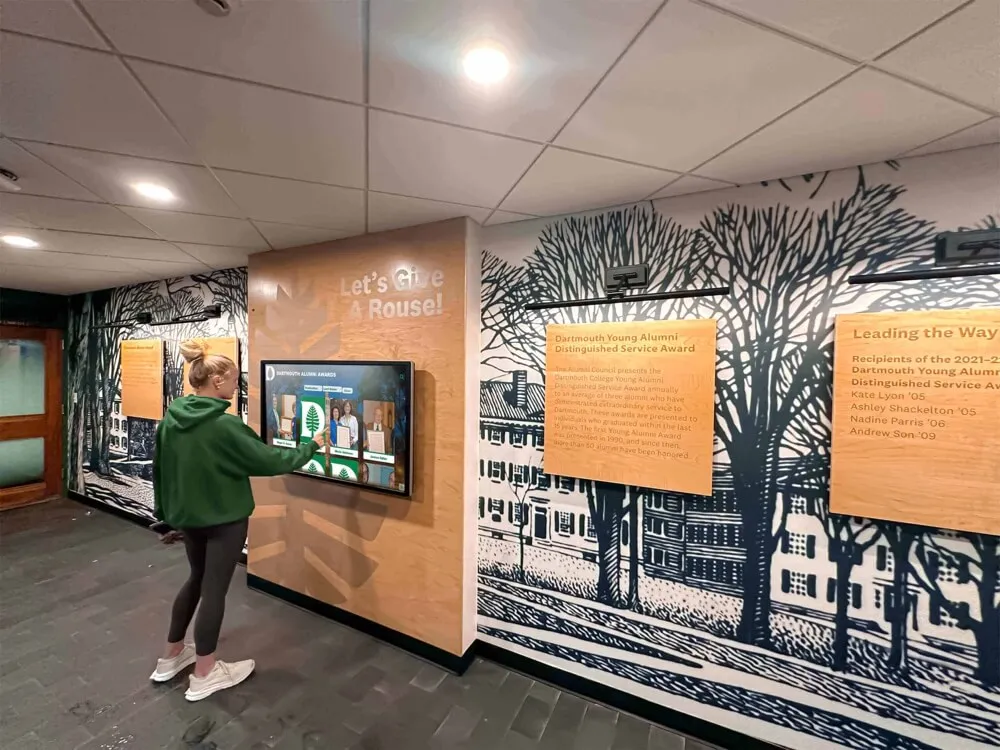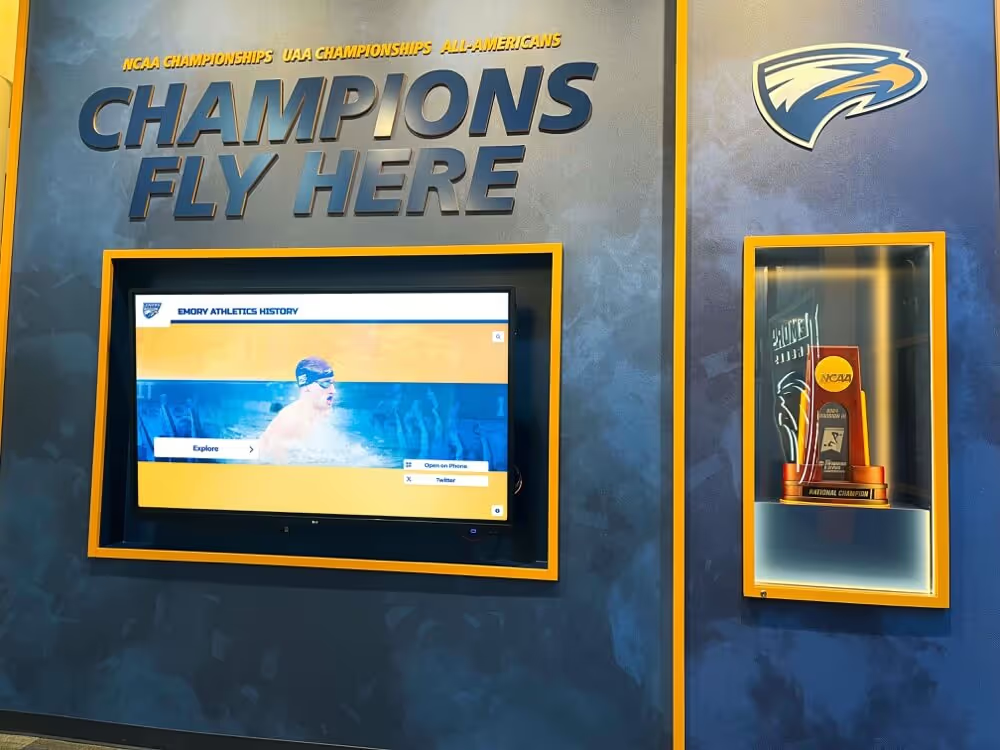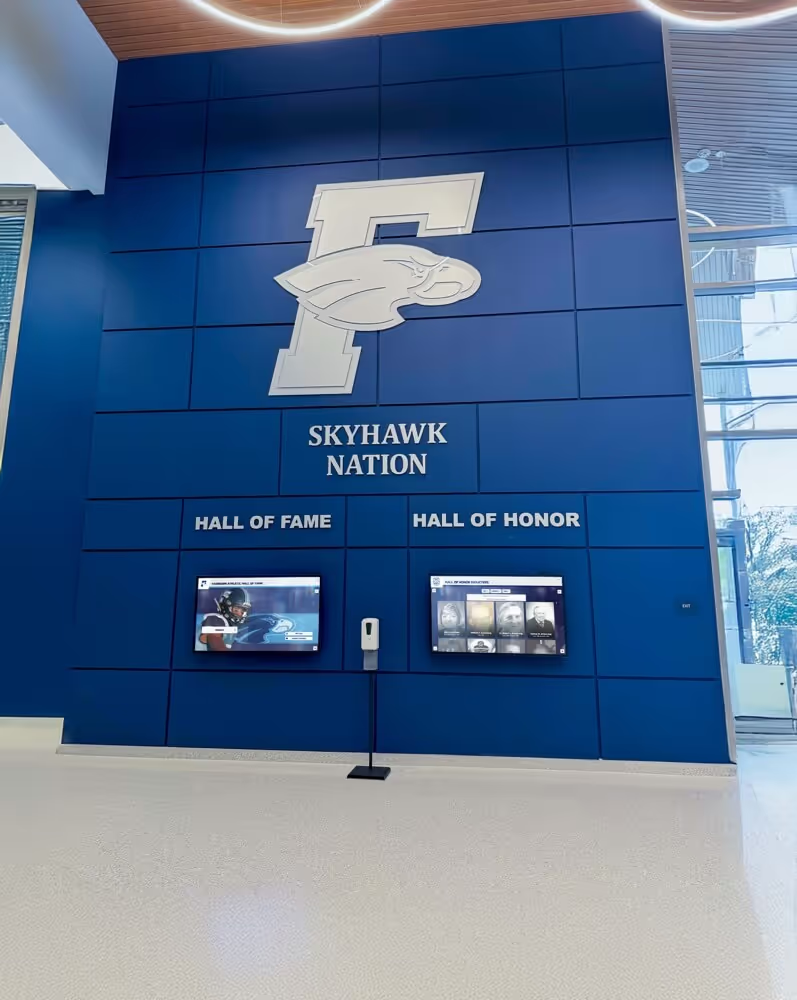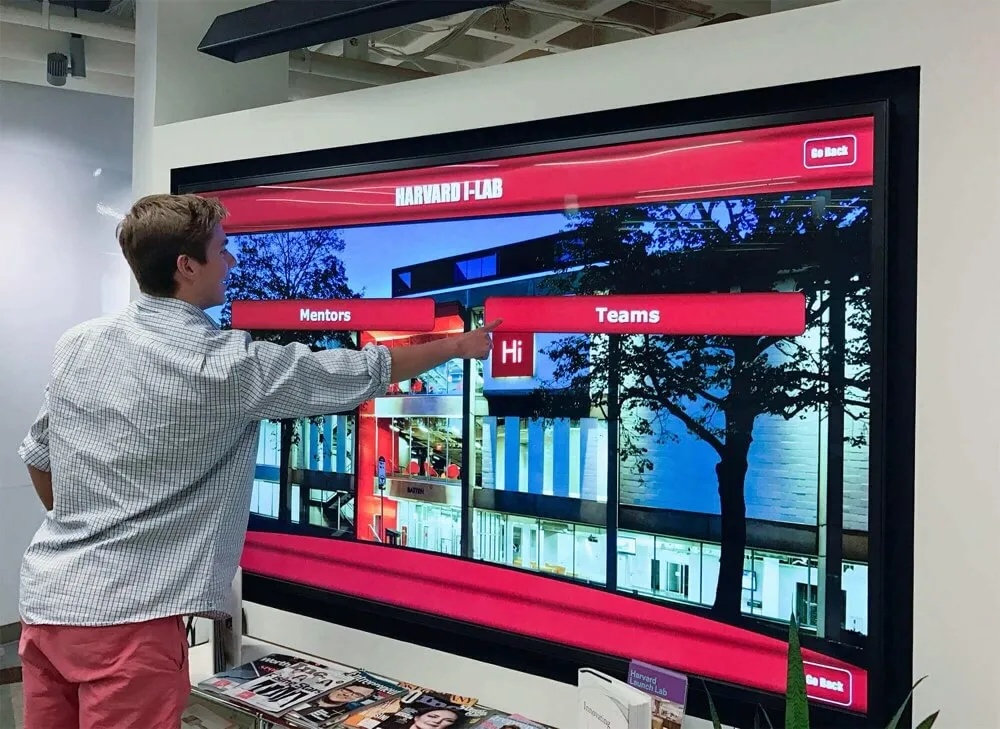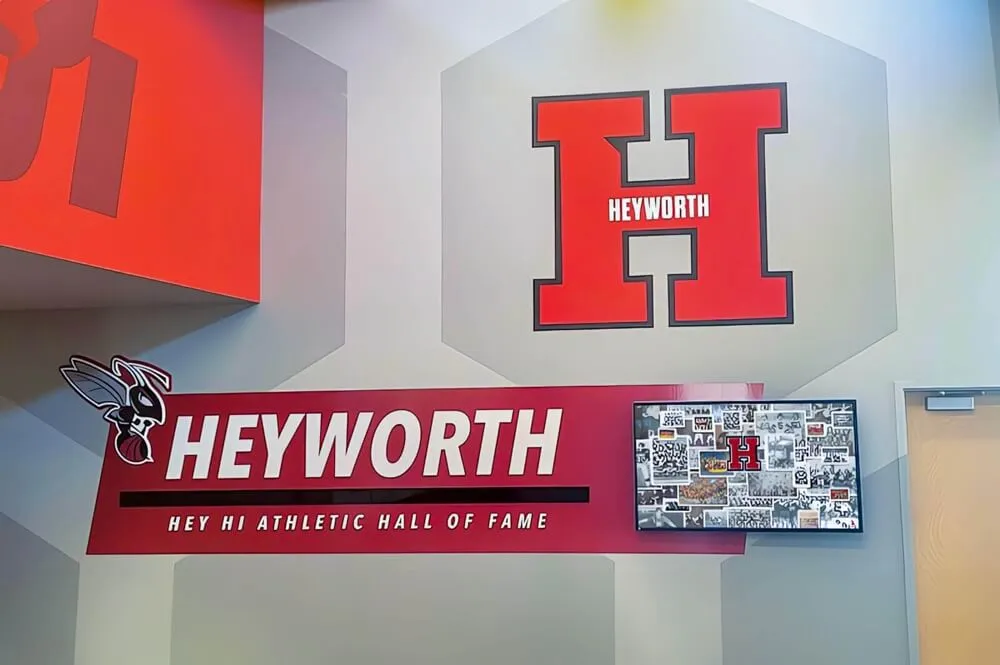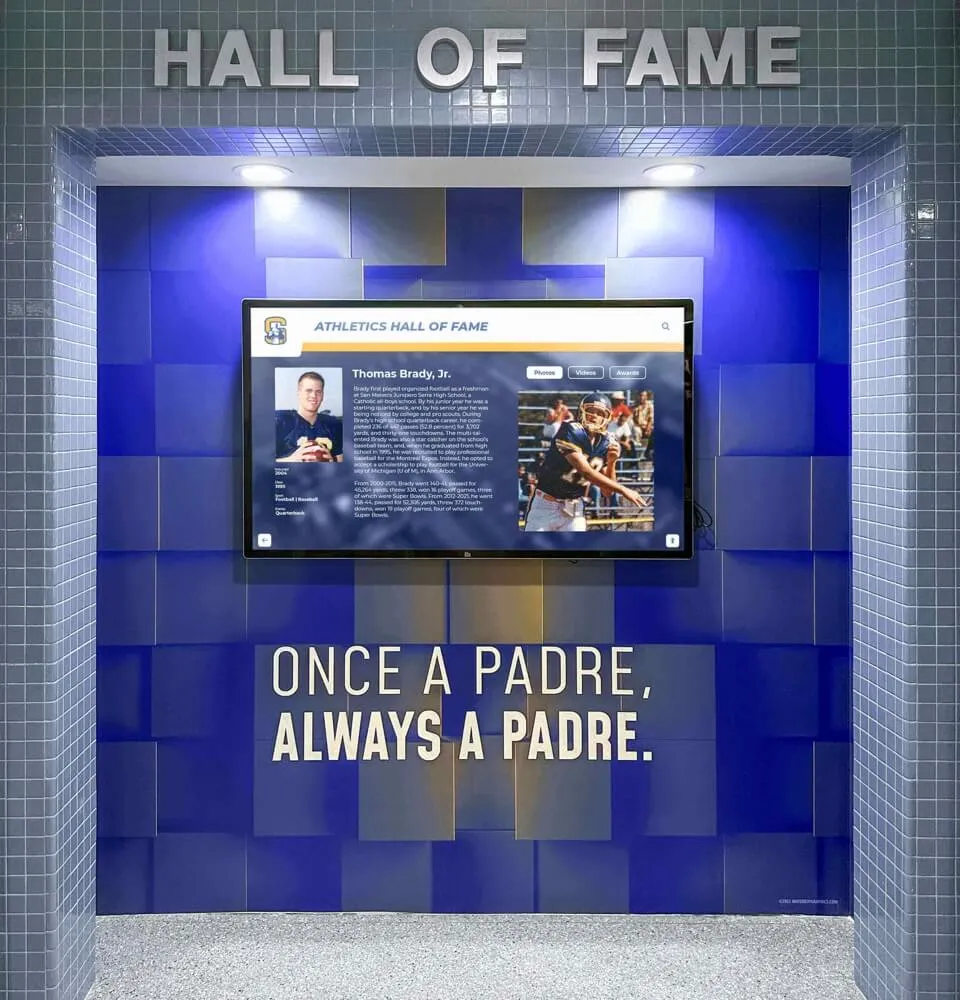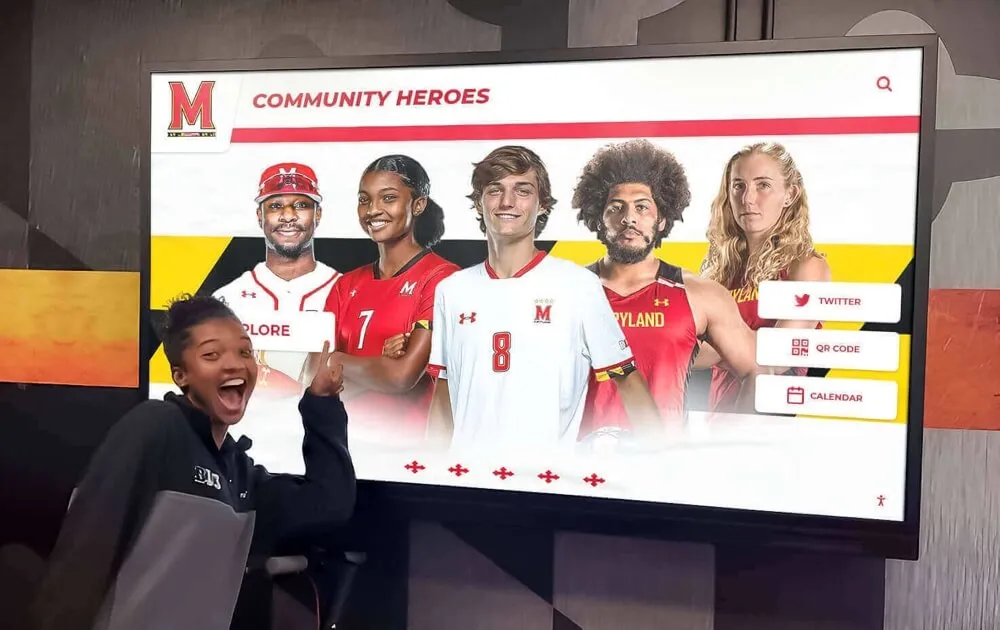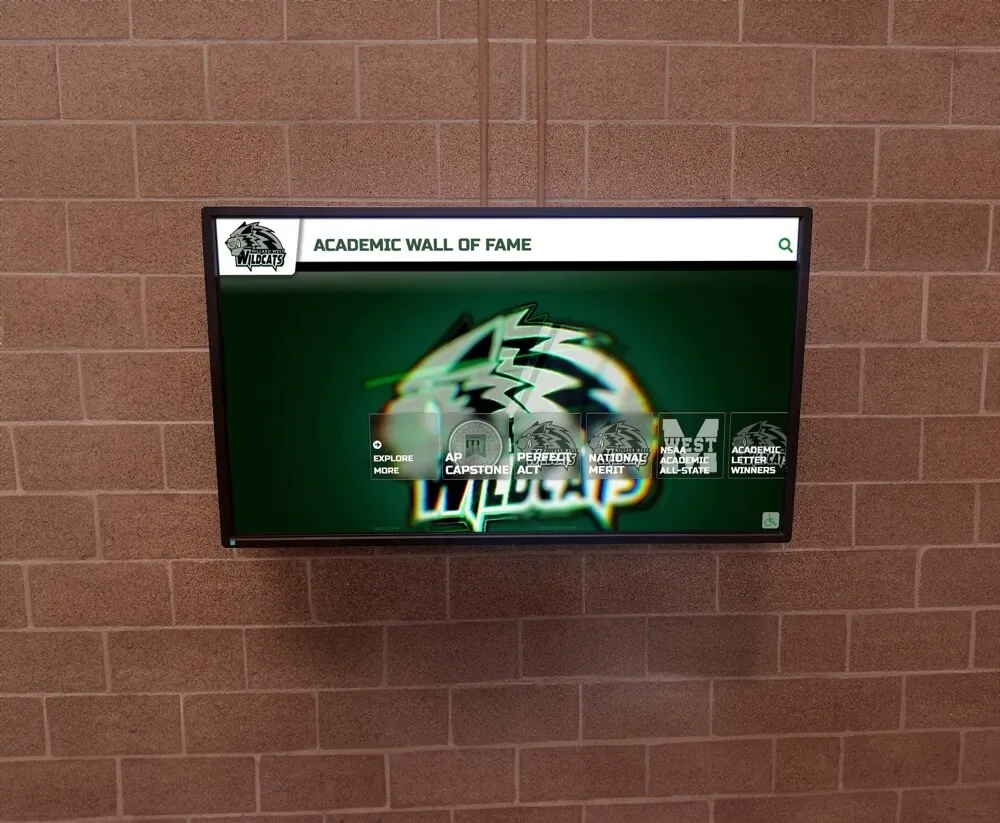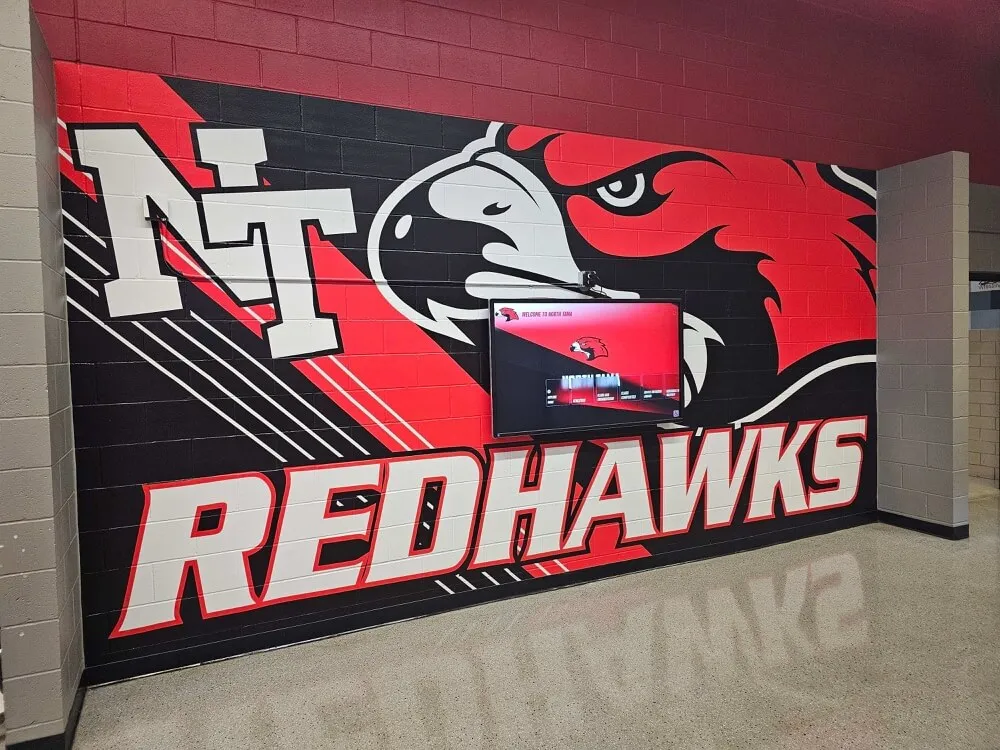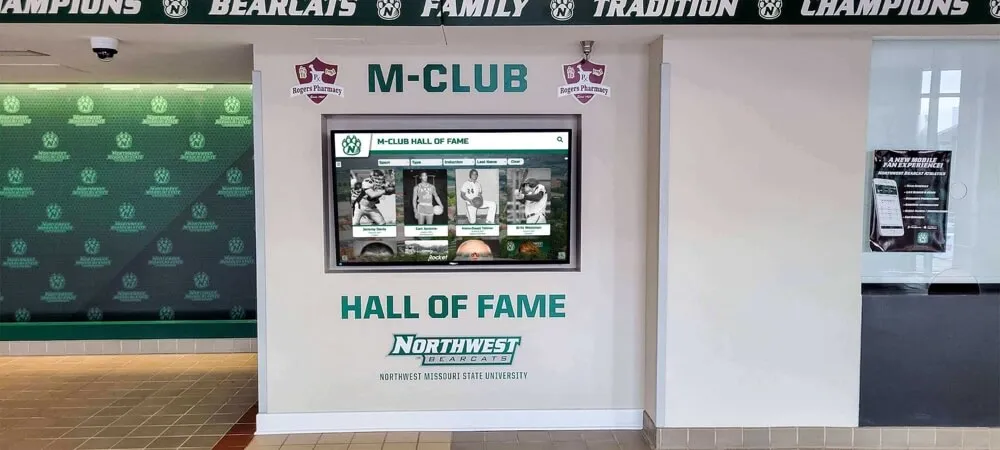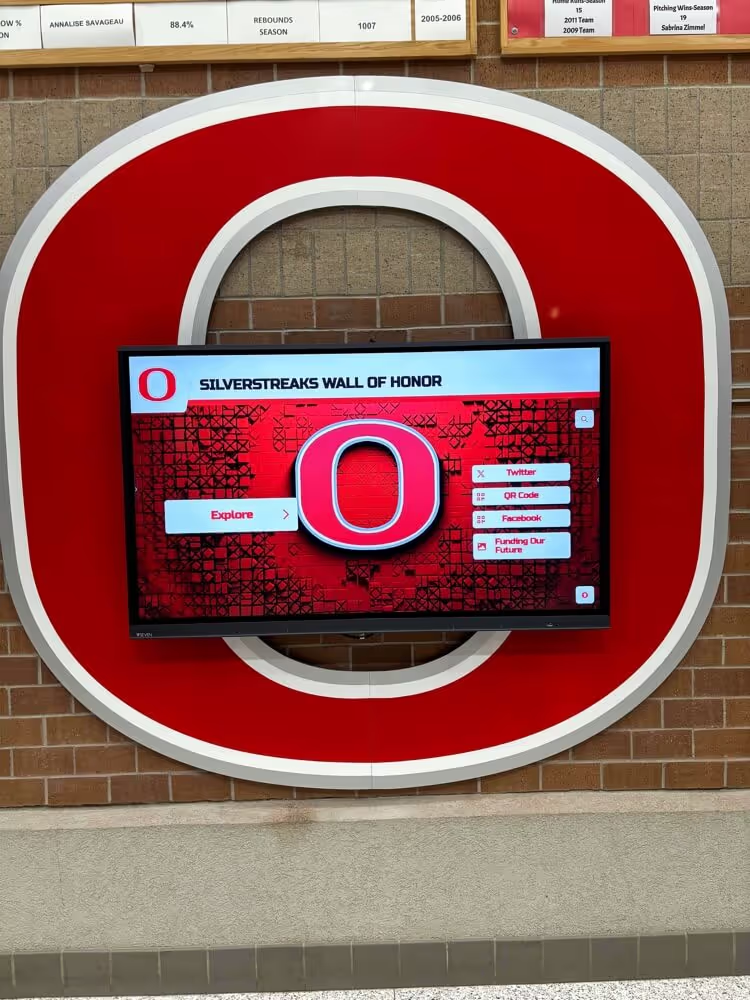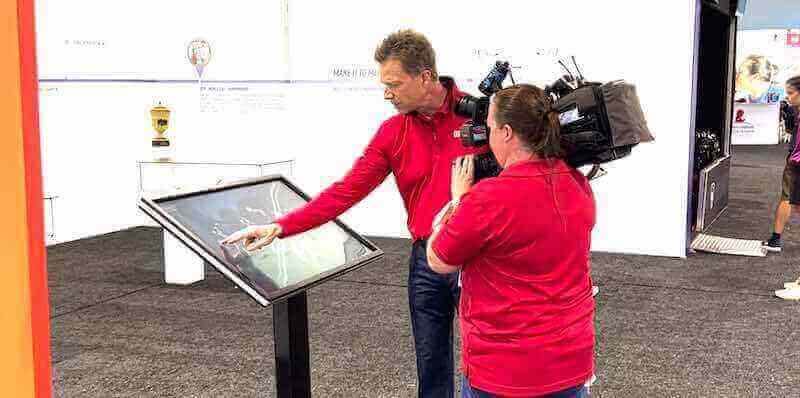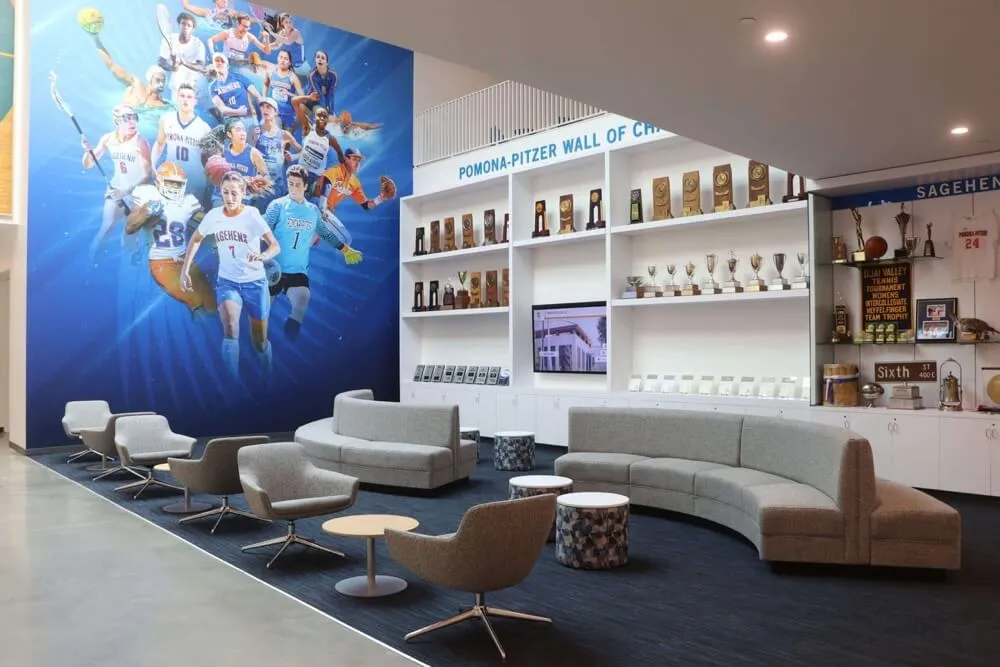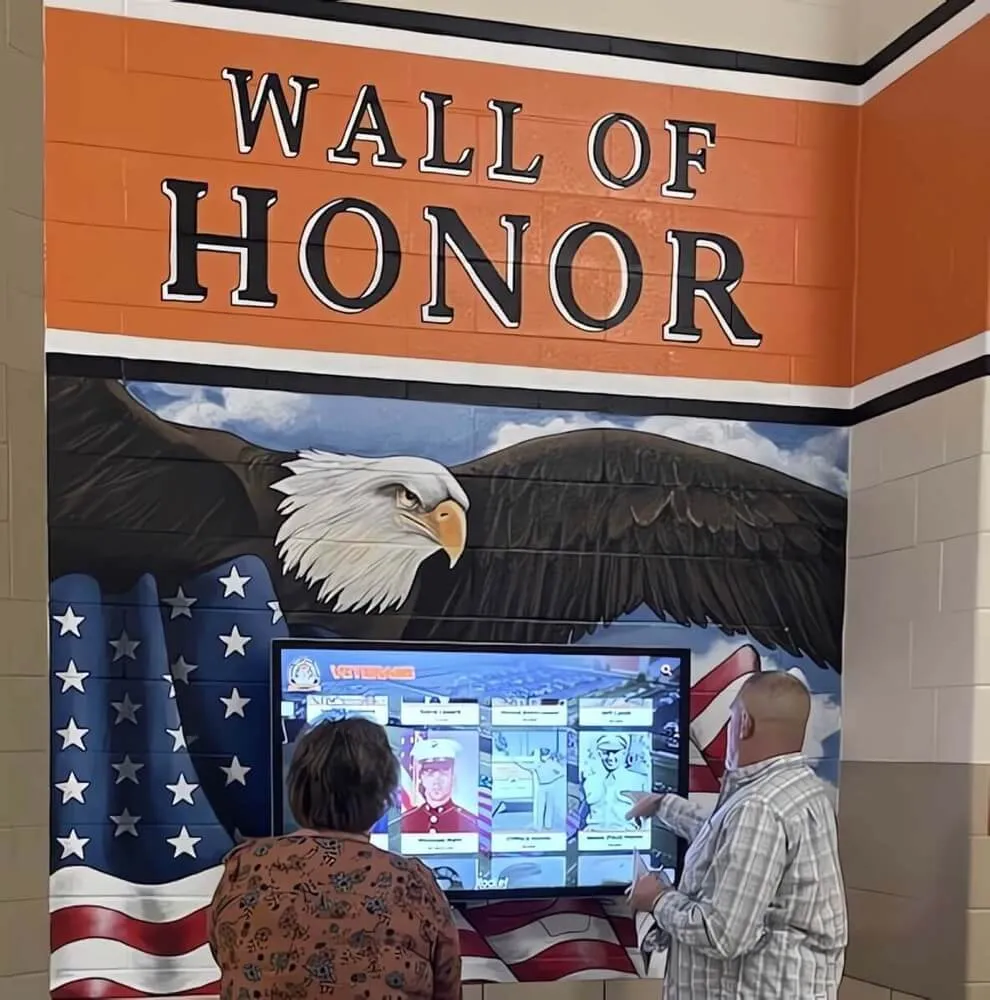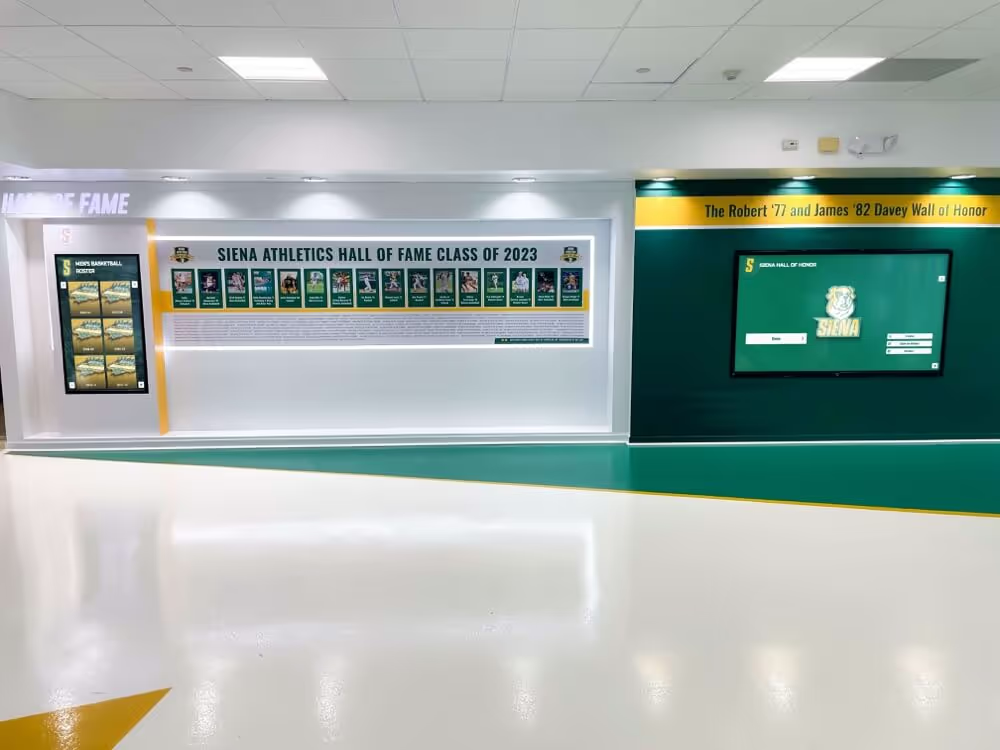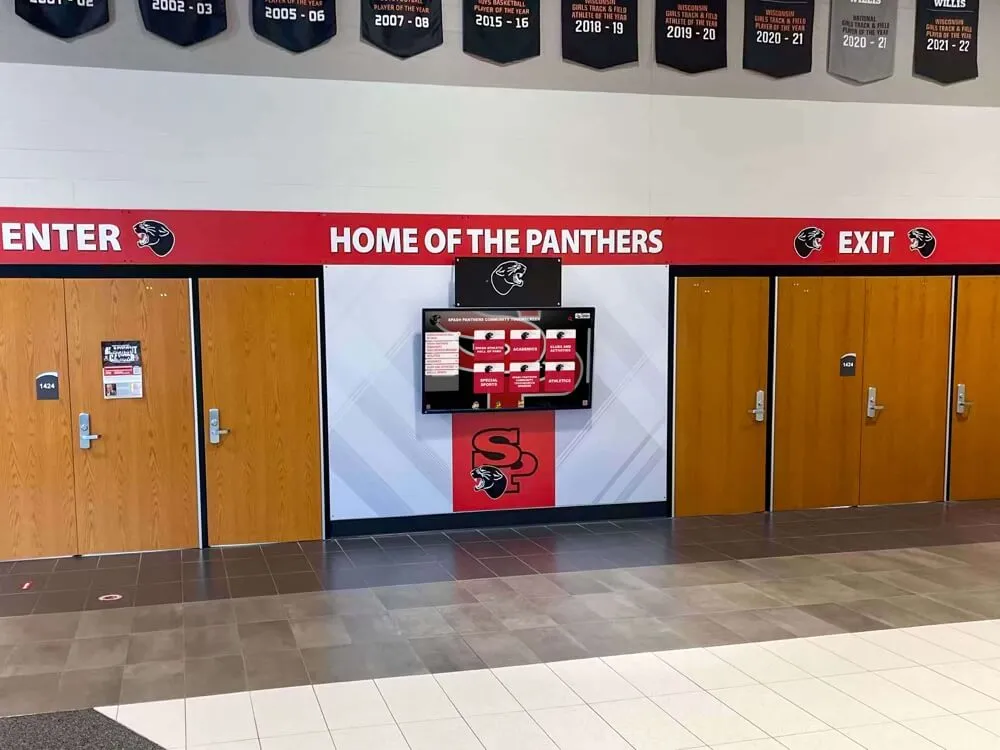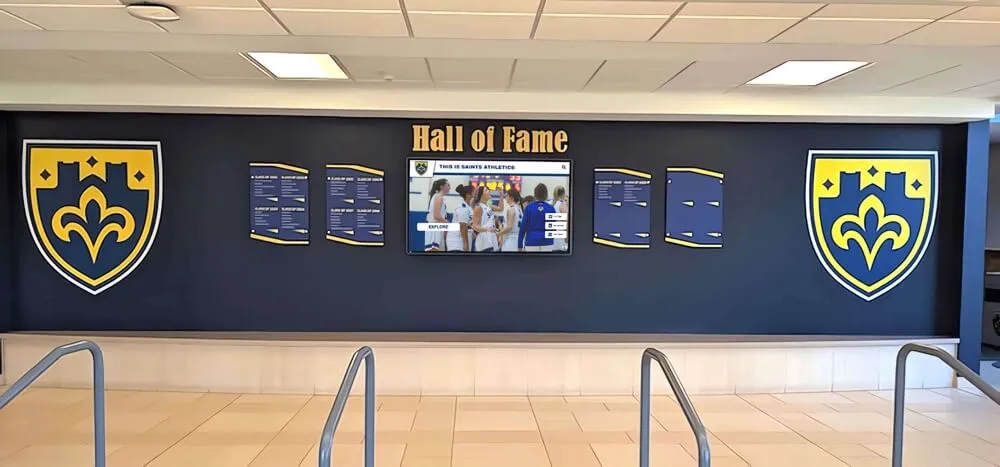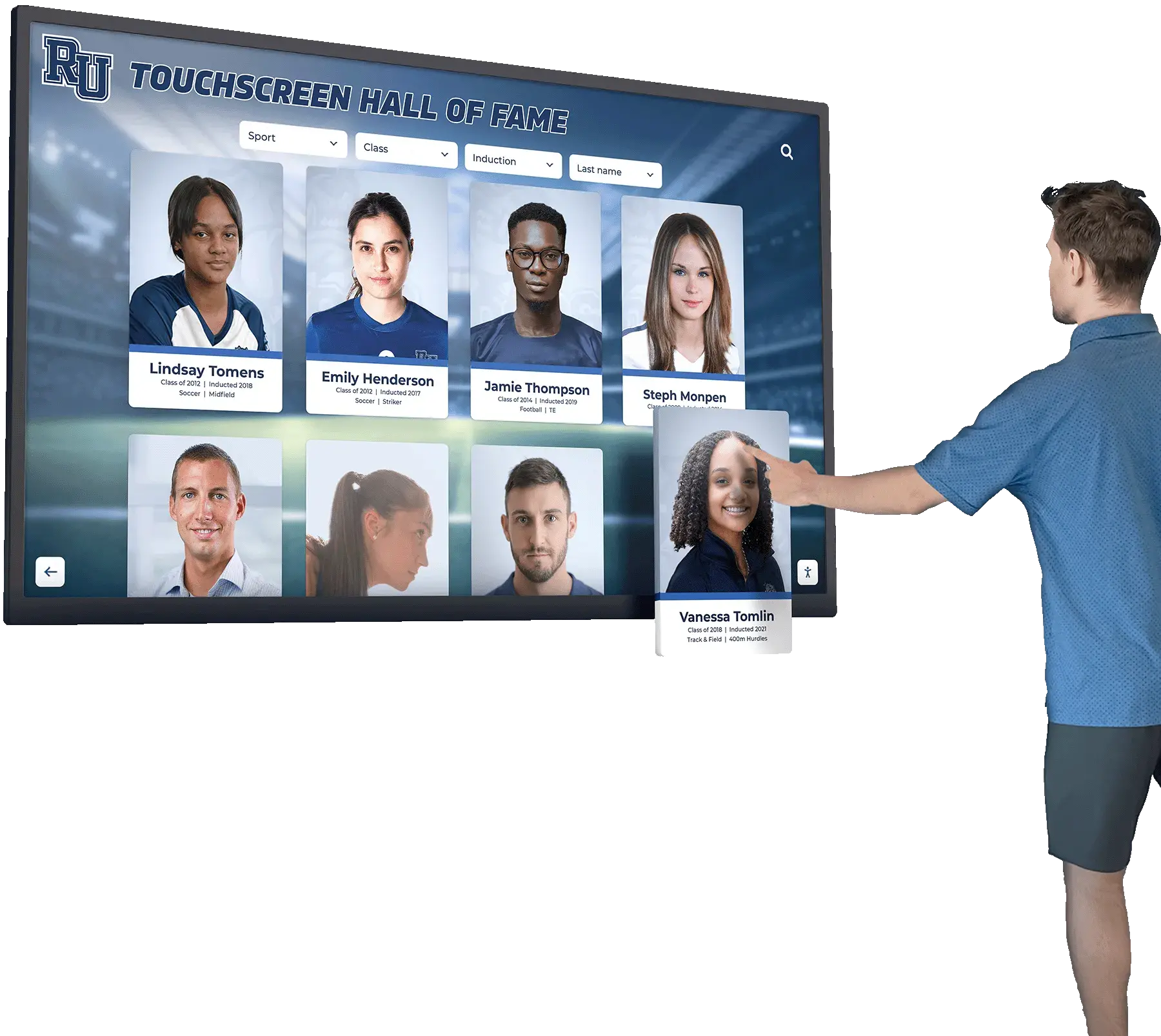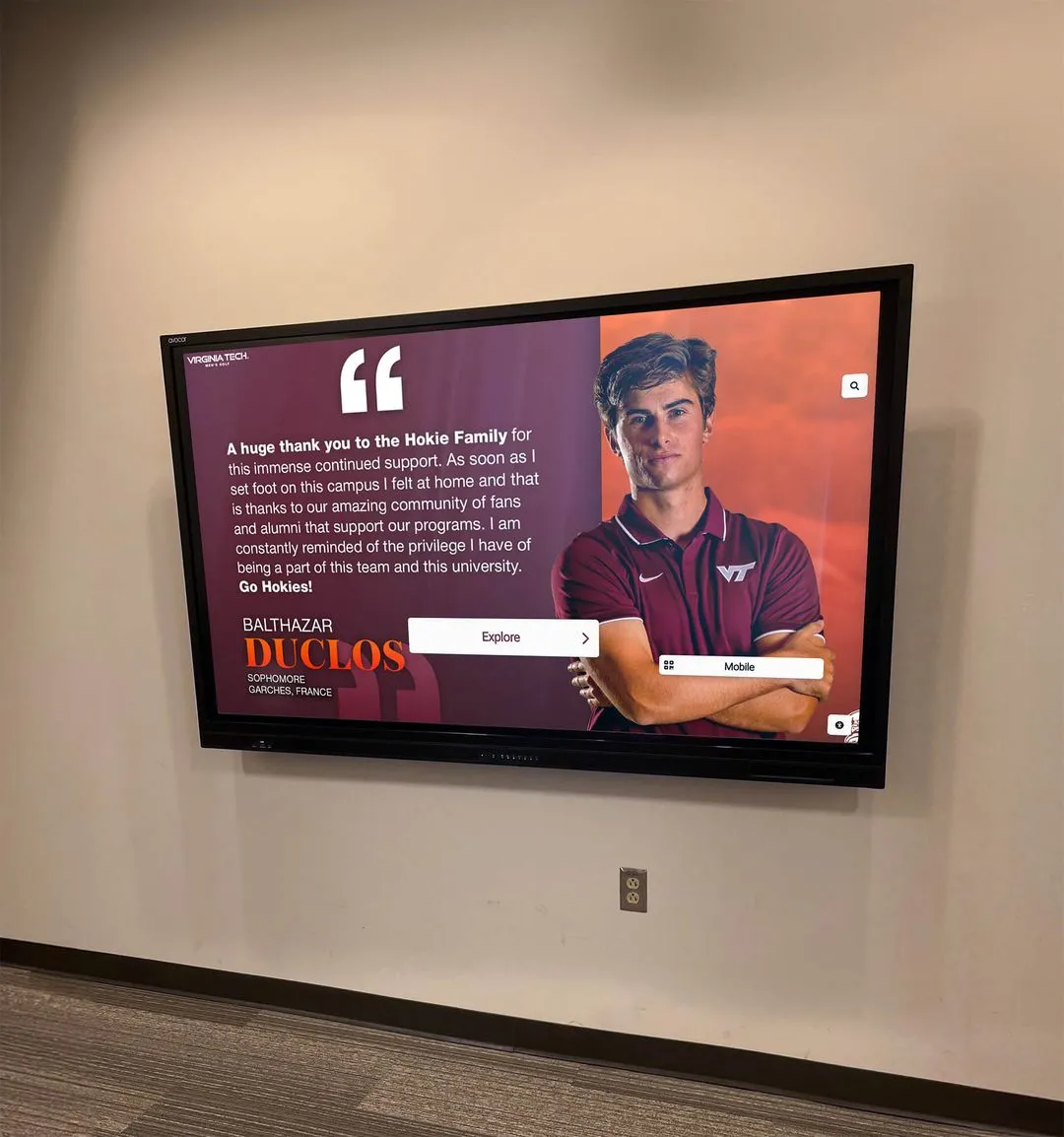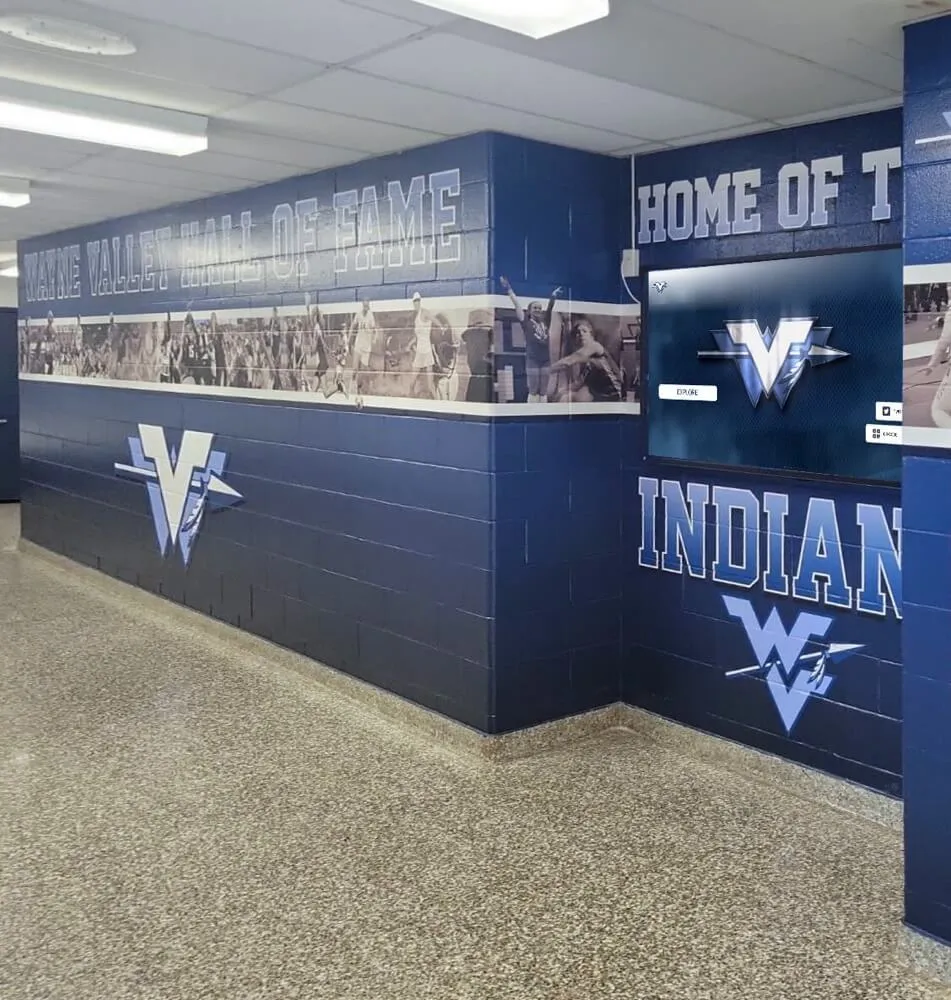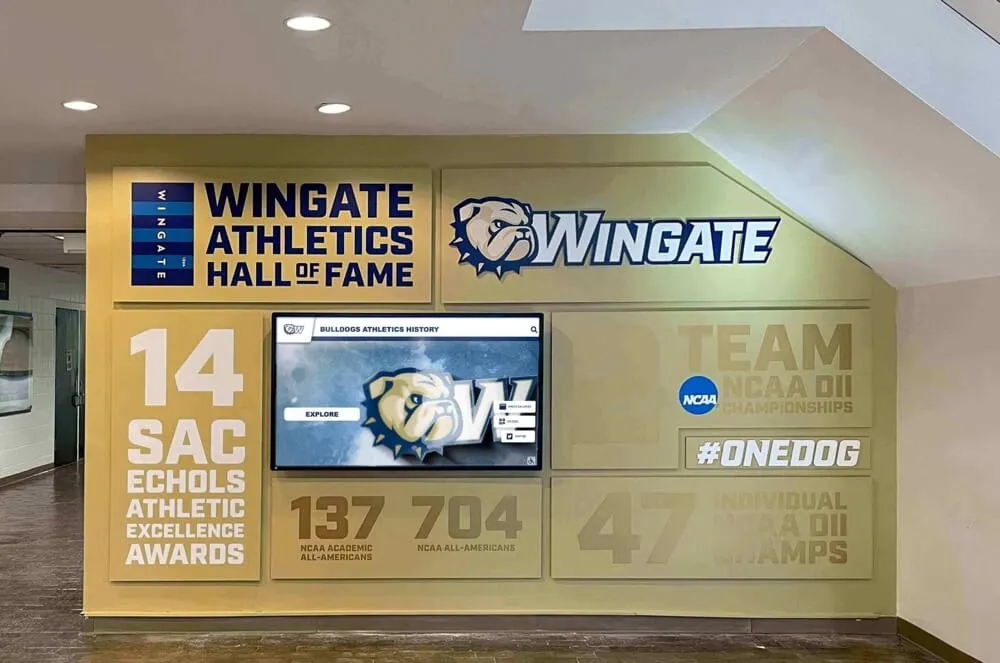Interactive Alumni Display Implementation: From Vision to Reality
Transforming your institution's recognition program with a touchscreen hall of fame represents a significant advancement in how you honor achievements and engage your community. This comprehensive implementation blueprint guides you through each phase of the process, from initial planning to successful launch and beyond.
Implementing a digital halls of fame requires careful planning, stakeholder alignment, and technical expertise. While the process may seem daunting, breaking it down into structured phases makes it manageable even for institutions with limited technical resources.
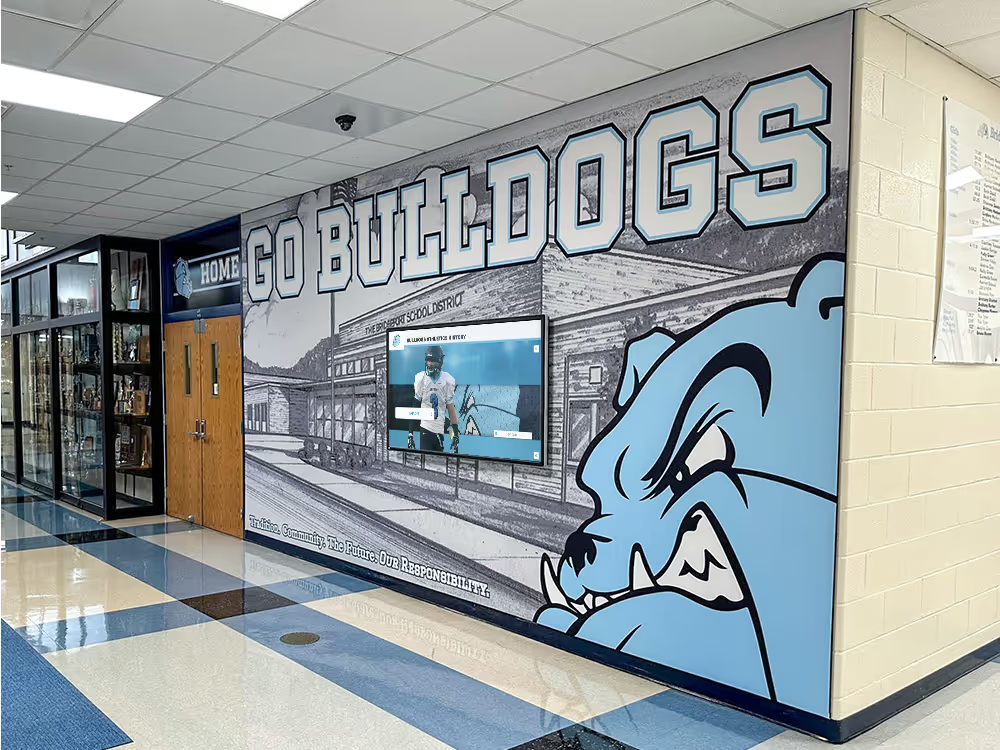
Installation team mounting an interactive alumni display at Bridgeport University's main entrance
Phase 1: Strategic Foundation (Weeks 1-4)
The success of your touchscreen hall of fame implementation begins with thorough strategic planning that aligns with your institution’s broader goals.
Defining Your Recognition Vision
Before selecting technology or gathering content, clearly articulate:
Core Purpose
What specific objectives will your digital recognition system serve? Examples include alumni engagement, student recruitment, donor recognition, community pride building, or preserving institutional history.
Recognition Scope
Which achievement categories will you feature? Consider athletics, academics, arts, service, career accomplishments, historical milestones, and donor contributions.
Audience Priorities
Who are your primary, secondary, and tertiary user groups? This might include current students, prospective families, alumni, donors, community members, and visitors.
Historical Depth
What time periods will you cover initially? Will you launch with recent achievements only and expand historically, or attempt a comprehensive archive from the start?
Building Your Implementation Team
Successful touchscreen hall of fame projects require diverse expertise and stakeholder representation:
- Core Implementation Team: 5-7 individuals with clear roles and responsibilities
- Executive Sponsor: Senior administrator who can remove obstacles and ensure institutional support
- Technical Lead: IT representative who understands network infrastructure and security requirements
- Content Curator: Individual responsible for gathering and organizing recognition materials
- Design Advocate: Person with visual design experience to ensure aesthetic quality
- User Representatives: Members from key stakeholder groups who provide perspective
Implementation Team Best Practice
Schedule consistent weekly meetings during the implementation process. The most successful projects maintain a regular 60-minute check-in where all team members provide updates, identify obstacles, and make collective decisions.
Comprehensive Budget Planning
Develop a realistic budget that addresses all implementation aspects:
| Budget Category | Percentage Range | Key Considerations |
|---|---|---|
| Hardware | 35-45% | Display size, touch capability, mounting solution, cabling, network equipment |
| Software & Platform | 20-30% | Content management system, customization, integration, licensing |
| Content Development | 15-25% | Digitization services, content creation, editing, organization |
| Physical Installation | 10-15% | Mounting hardware, structural work, electrical, network connectivity |
| Training & Documentation | 5-10% | Staff training, documentation development, support materials |
| Contingency | 10-15% | Unexpected costs, scope adjustments, price fluctuations |
"The most critical decision we made was budgeting adequate resources for content development. While the technology is important, the quality of your content ultimately determines the impact of your interactive alumni display. We initially underestimated the time required to gather, digitize, and organize our historical recognition materials."
— Director of Advancement, Westfield Community School
Phase 2: Location and Hardware Planning (Weeks 3-6)
Physical placement and hardware selection are crucial decisions that affect both visitor experience and ongoing management.
Strategic Location Selection
The placement of your touchscreen hall of fame significantly impacts its visibility and usage patterns:
Primary Entrance
Pros: Maximum visibility, first impression for visitors
Cons: May create congestion, limited viewing time
Main Hallway
Pros: High traffic, natural stopping point
Cons: Noise concerns, limited wall space
Community Area
Pros: Extended viewing time, comfortable environment
Cons: Potentially lower visibility
Athletic Facility
Pros: Context-relevant for sports recognition
Cons: Limited to athletics audience
Administrative Building
Pros: Security, controlled environment
Cons: Limited public access
Library/Media Center
Pros: Natural research environment, quiet
Cons: Potentially limited hours
When evaluating locations, consider these essential factors:
- Traffic Patterns: Areas with consistent but not overwhelming foot traffic
- Dwell Time: Spaces where visitors can comfortably spend 5-10 minutes exploring
- Environmental Factors: Lighting conditions, noise levels, and climate control
- Infrastructure Access: Proximity to power, network connectivity, and structural support
- Security Considerations: Visibility to staff and/or security cameras
- Expansion Potential: Space for additional displays if your system grows
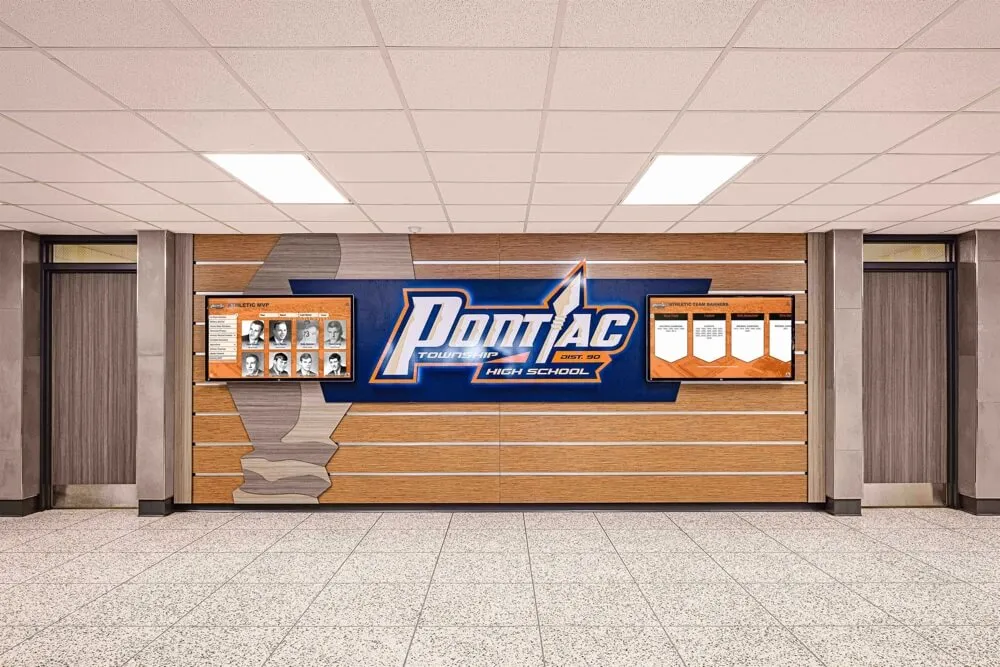
Pontiac High School's digital halls of fame strategically placed at the junction of two main hallways for maximum visibility
Hardware Configuration Selection
Your hardware choices should align with your content strategy and location constraints:
Display Configuration Options
Single Large Display
- Best for focused content presentation
- Typically 55"-75" commercial-grade touchscreen
- Simplest implementation, lowest hardware cost
- Limited to single-user interaction at a time
Multi-Screen Array
- Dramatic visual impact for prominent locations
- Can separate content by category across screens
- Allows multiple simultaneous users
- Higher hardware and installation costs
Interactive Kiosk
- Freestanding solution requiring no wall mounting
- Can be repositioned as needed for events
- Often includes ADA accessibility features
- Requires floor space rather than wall space
Video Wall
- Maximum visual impact for showcase locations
- Combines interactive and passive display zones
- Highest hardware and installation investment
- Best for institutions with substantial content
Technical Infrastructure Assessment
Before finalizing hardware decisions, evaluate your existing infrastructure:
- Network Capabilities: Bandwidth, reliability, and security requirements
- Power Availability: Dedicated circuits, backup power options
- Structural Considerations: Wall strength, mounting requirements
- Environmental Controls: HVAC, humidity, and dust management
- Physical Security: Protection from tampering or damage
| Technical Requirement | Minimum Specification | Recommended Specification |
|---|---|---|
| Network Bandwidth | 10 Mbps dedicated | 25+ Mbps dedicated |
| Power Requirements | 15 amp circuit per display | Dedicated 20 amp circuit with surge protection |
| Wall Support | Capable of supporting 2x display weight | Reinforced mounting with 3x weight capacity |
| Internet Connectivity | Standard institutional Wi-Fi | Hardwired ethernet connection |
| Security Coverage | Visible to existing cameras | Dedicated monitoring and alarm integration |
Phase 3: Content Strategy and Collection (Weeks 5-12)
Content quality ultimately determines your interactive alumni display’s impact and longevity.
Recognition Framework Development
Create a structured approach to organizing your recognition content:
Category Architecture
Define your primary content categories and subcategories with clear organizational logic. Common structures include:
- Recognition type (athletics, academics, service)
- Time periods (decades, eras, administrations)
- Achievement level (hall of fame, annual awards)
Content Depth Standards
Establish consistent profiles across recognition categories:
- Biographical information requirements
- Achievement documentation standards
- Minimum and optional media elements
- Citation and verification requirements
Content Collection Campaign
Implementing a systematic approach to content gathering:
- Inventory Existing Resources: Catalog current recognition displays, archives, and databases
- Prioritize Collection Efforts: Focus initial gathering on highest-priority categories
- Develop Collection Tools: Create standardized submission forms and processes
- Launch Engagement Campaign: Communicate the project and collection needs to stakeholders
- Establish Processing Workflow: Define how materials move from submission to publication
Content Collection Accelerator: Community Digitization Event
Many institutions dramatically accelerate their content collection by hosting a dedicated "Memory Collection Day" where alumni and community members can bring historical materials for on-site digitization. With proper planning, a single well-promoted event can yield more quality content than months of individual outreach.
- Scanning stations for photos and documents
- Video recording booths for oral histories
- Data collection tables for biographical information
- Authentication process for verifying achievements
- Refreshments and social components to encourage attendance
Content Processing and Enhancement
Raw materials must be transformed into engaging interactive content:
- Digitization Standards: High-resolution scanning, proper file formats
- Media Enhancement: Photo restoration, audio cleaning, video optimization
- Metadata Application: Consistent tagging for search and filtering
- Narrative Development: Creating compelling stories around achievements
- Cross-Reference Creation: Establishing connections between related content
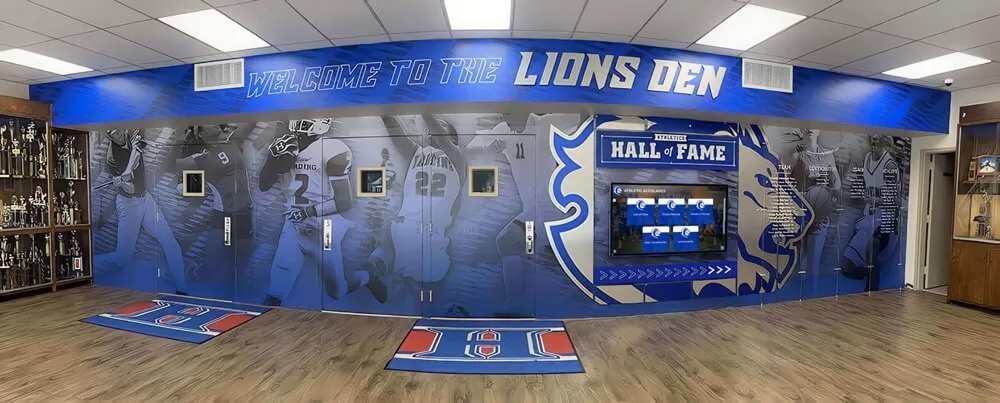
Harding Academy's content team processing historical materials for their touchscreen hall of fame
Phase 4: Platform Selection and Configuration (Weeks 10-16)
The software platform powering your interactive alumni display determines its functionality, user experience, and management complexity.
Platform Selection Criteria
Evaluate potential software solutions against these key factors:
Content Management
- Intuitive administrative interface
- Batch update capabilities
- Media library management
- Role-based access controls
- Content approval workflows
User Experience
- Touch-optimized interface
- Intuitive navigation patterns
- Search and filter capabilities
- Multiple language support
- Accessibility compliance
Technical Architecture
- Cloud vs. on-premise hosting
- Security features and compliance
- Backup and recovery options
- Integration capabilities
- Performance optimization
Design Flexibility
- Brandable interface elements
- Custom template capabilities
- Layout control and flexibility
- Typography and color scheme options
- Visual theme variety
Engagement Features
- Social media integration
- Email capture functionality
- Usage analytics and reporting
- User contribution capabilities
- Interactive elements and games
Support & Sustainability
- Vendor reputation and stability
- Support response and availability
- Update frequency and process
- User community and resources
- Total cost of ownership
Platform Configuration and Customization
Once selected, your platform must be configured to match your institution’s needs:
- Visual Branding: Apply institutional colors, logos, and design standards
- Content Structure: Implement your recognition framework and navigation
- User Interface Customization: Optimize interactions for your specific audience
- Integration Implementation: Connect with existing systems where appropriate
- Role and Permission Setup: Configure administrative access levels
"Our biggest implementation lesson was the importance of a thorough platform evaluation. We initially chose a solution based primarily on cost, but later discovered it lacked critical features for managing our complex athletic records. The subsequent platform migration cost us more than selecting the right solution from the start would have."
— Technology Director, North State Academy
Phase 5: Installation and Testing (Weeks 15-20)
The physical installation and system testing phase transforms planning into reality.
Pre-Installation Preparation
Before hardware arrives, complete these critical preparatory steps:
- Site Preparation: Wall reinforcement, power installation, network drops
- Equipment Staging: Secure storage area for hardware upon delivery
- Installation Schedule: Coordinated timeline with facilities and IT
- Contingency Planning: Alternate timeframes if complications arise
- Security Notifications: Alert relevant personnel about installation activities
Physical Installation Process
The installation process typically includes:
Day 1: Site Preparation
- Final site measurements and verification
- Wall preparation and reinforcement
- Cable routing and connectivity testing
- Power system installation and testing
Day 2: Hardware Mounting
- Display mount installation
- Display hardware positioning and securing
- Cable connection and management
- Initial power-up and hardware testing
Day 3: System Configuration
- Operating system configuration
- Software installation and setup
- Network configuration and security
- Content synchronization and loading
Day 4: Final Testing
- Comprehensive functionality testing
- Performance optimization
- Security verification
- Aesthetic finishing and cleanup
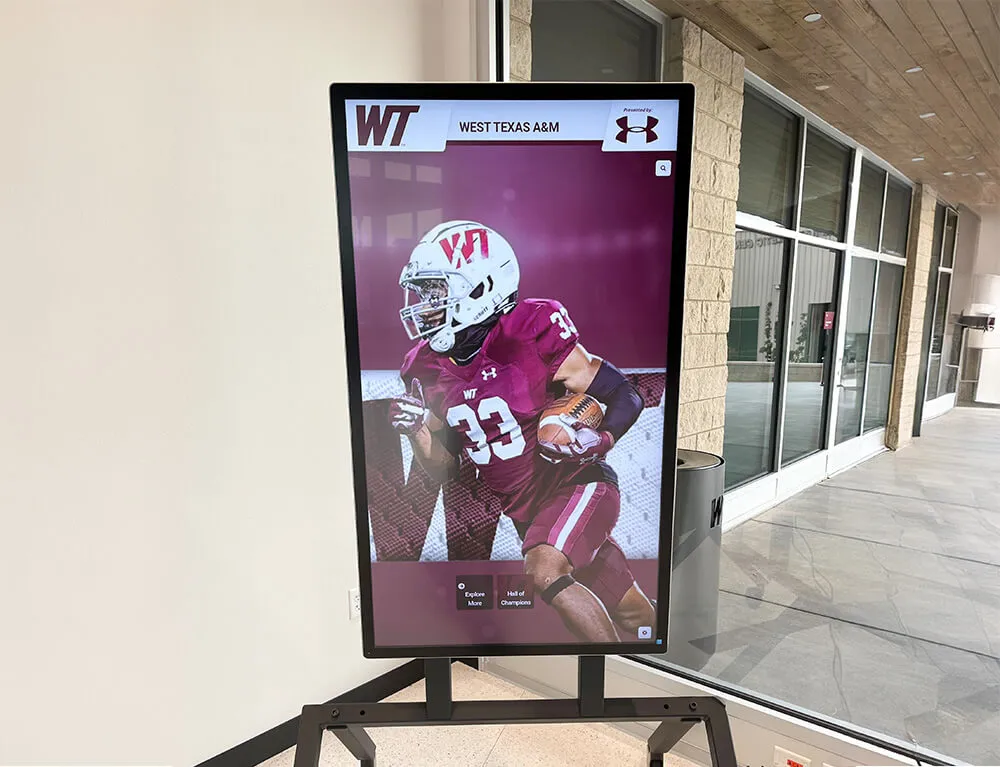
Installation team completing the mounting of West Texas High School's digital donor recognition wall
Comprehensive Testing Protocol
Before public launch, conduct these essential tests:
Critical Testing Categories
Functionality Testing
- Touch responsiveness and accuracy
- Navigation flow and logic
- Search and filter operation
- Media playback quality
- Interactive feature validation
Content Verification
- Text accuracy and formatting
- Image quality and cropping
- Video and audio playback
- Link functionality
- Category organization
Performance Assessment
- Response time measurements
- Load testing with maximum content
- Concurrent user simulation
- Long-duration reliability testing
- Resource utilization monitoring
User Experience Validation
- Intuitive navigation verification
- First-time user observation
- Accessibility compliance checking
- Multi-generational usability testing
- Stakeholder feedback collection
Phase 6: Staff Training and Documentation (Weeks 19-22)
Prepare your team to manage the touchscreen hall of fame effectively:
Training Program Structure
Develop role-specific training for different stakeholder groups:
- System Administrators: Complete technical management training
- Content Managers: Focused on day-to-day updates and content maintenance
- General Staff: Basic functionality overview and promotional guidance
- Executive Overview: High-level capabilities and strategic usage
Live Training Sessions
Hands-on workshops where staff practice using the system with guidance from implementation experts.
Video Tutorials
Task-specific recordings demonstrating common procedures and troubleshooting techniques.
Written Documentation
Comprehensive reference materials covering all system aspects and procedures.
Documentation Development
Create comprehensive reference materials for ongoing support:
- Administrative Manual: Complete system management procedures
- Content Guidelines: Standards for creating and formatting content
- User Guides: How-to documentation for different user roles
- Troubleshooting Guide: Common issues and resolution steps
- Frequently Asked Questions: Responses to common inquiries
Documentation Best Practice: Sustainability Planning
The most successful implementations include a "system sustainability plan" that addresses staff turnover by documenting:
- Key system knowledge and where it resides
- Cross-training requirements to ensure redundancy
- Calendar of regular maintenance activities
- Onboarding process for new staff
- Technology replacement and upgrade schedule
Phase 7: Launch and Promotion (Weeks 21-24)
Maximize the impact of your interactive alumni display through strategic launch activities:
Phased Launch Approach
A graduated approach to public release:
- Soft Launch: Limited access for core stakeholders to provide feedback
- Preview Events: Special showings for key constituent groups
- Official Unveiling: Formal ceremony with media coverage
- General Availability: Full public access with support staff available
Promotional Strategy
Amplify awareness through multi-channel communication:
Internal Channels
- School announcements and assemblies
- Faculty and staff meetings
- Student orientation sessions
- Parent communication systems
- Internal newsletters and bulletins
External Channels
- Alumni communications and social media
- Local media coverage and press releases
- Community events and open houses
- Institutional website and digital channels
- Industry publications and educational media
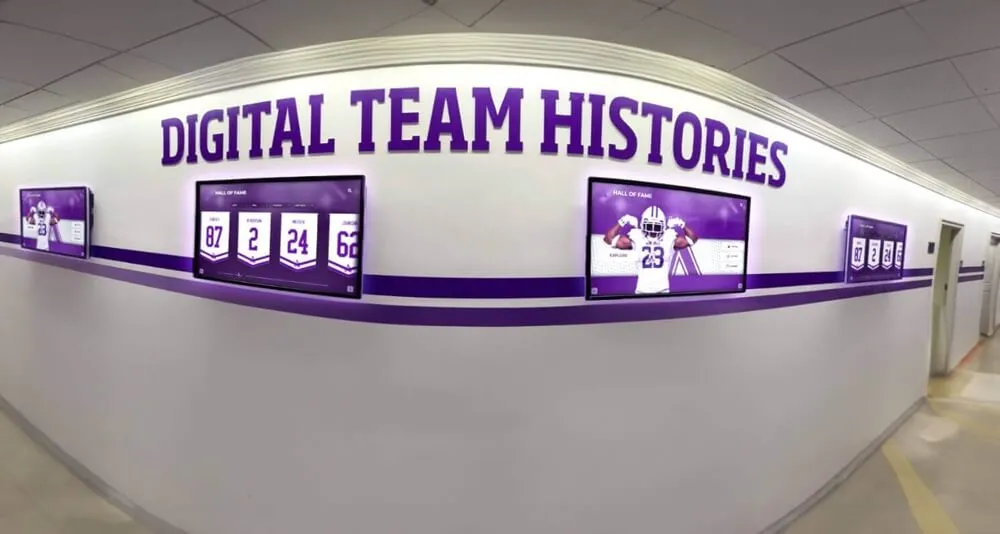
Ribbon-cutting ceremony for Amherst College's new touchscreen hall of fame attended by alumni, administration, and local media
Phase 8: Ongoing Management and Evolution (Post-Launch)
Ensure long-term success through systematic management and continuous improvement:
Regular Maintenance Schedule
Establish a predictable rhythm of system care:
| Maintenance Activity | Frequency | Responsible Party |
|---|---|---|
| Content Updates | Monthly or as needed | Content Manager |
| Physical Cleaning | Weekly | Facilities Staff |
| Software Updates | As released or quarterly | IT Administrator |
| Full Content Audit | Annually | Implementation Team |
| Usage Analytics Review | Quarterly | Project Lead |
| Backup Verification | Monthly | System Administrator |
Continuous Improvement Process
Establish mechanisms for ongoing enhancement:
- Feedback Collection: Systematic gathering of user input
- Usage Analysis: Monitoring of interaction patterns and engagement
- Feature Prioritization: Structured evaluation of potential improvements
- Content Expansion: Regular addition of new recognition materials
- Technology Refresh: Scheduled evaluation of hardware and software updates
Measuring Implementation Success
Establish metrics to evaluate your touchscreen hall of fame's impact:
Engagement Metrics
- Average interaction time per session
- Number of daily/weekly/monthly users
- Content exploration depth
- Return visitor percentage
- Content category popularity
Stakeholder Impact
- Alumni engagement increase
- Donor interest attribution
- Student recruitment influence
- Community feedback sentiment
- Media coverage and mentions
Overcoming Common Implementation Challenges
Every touchscreen hall of fame implementation faces obstacles. Here’s how to address the most common challenges:
Budget Constraints
When funding limitations threaten project viability:
- Implement in phases with clear expansion roadmap
- Focus initial scope on highest-impact recognition
- Explore sponsorship opportunities from alumni
- Consider lease options instead of outright purchase
Content Gaps
When historical information is incomplete:
- Acknowledge limitations transparently
- Create contribution mechanisms for community input
- Implement verification protocols for submissions
- Use placeholder content with appeals for information
Stakeholder Resistance
When key constituents oppose digital transition:
- Demonstrate how digital enhances rather than replaces
- Create complementary physical/digital experiences
- Involve skeptical stakeholders in design decisions
- Showcase successful implementations at peer institutions
Technical Limitations
When infrastructure constraints create barriers:
- Explore cloud-based solutions with minimal local requirements
- Implement content caching to reduce bandwidth needs
- Consider standalone systems with scheduled updates
- Leverage mobile device integration for expansion
Conclusion: Your Implementation Roadmap to Success
Implementing a digital halls of fame represents a significant advancement in how your institution celebrates achievements and engages your community. By following this comprehensive implementation blueprint, you can navigate the process confidently while avoiding common pitfalls.
Remember that successful implementation is not just about technology deployment—it’s about creating a living, dynamic recognition system that evolves with your institution and continues to engage stakeholders for years to come.
Ready to Begin Your Implementation Journey?
Rocket Alumni Solutions provides comprehensive implementation support, from initial planning through successful launch and beyond. Our experienced team has guided hundreds of institutions through the process of creating engaging touchscreen halls of fame.
Request Your Implementation ConsultationThe transformation from traditional recognition displays to an interactive digital system is a journey—but with proper planning, stakeholder engagement, and technical execution, it’s one that delivers lasting value to your institution and community.
